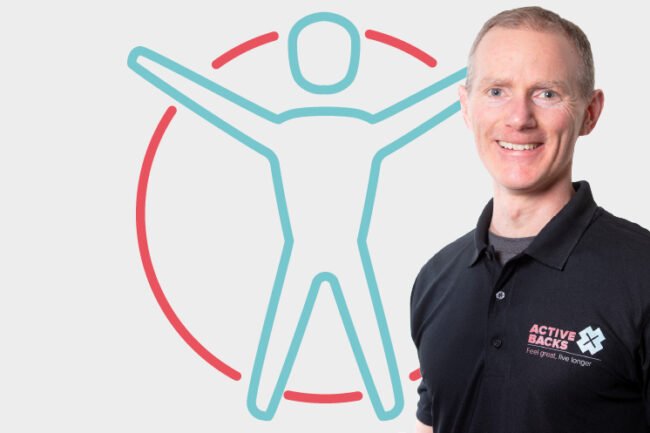How to get your socks on with back pain / sciatica
How to get your socks on with back pain / sciatica
Today’s episode is entitled “How to get your socks on with back pain / sciatica”. You will learn:
- The role of inflammation and disc swelling
- The value of warming up (or just waiting)
- How to actually get your socks on with back pain / sciatica

The role of inflammation and disc swelling
If you have lower back pain / sciatica, it’s probably related to some degree of inflammation in the small of your back. It doesn’t matter what the origin of that is or what the tissue is (muscle, ligament, disc, tendon). There is a good chance that you have chronic (more than 12 weeks) or acute (less than 6 weeks) inflammation. Of course, we’ve got a gap of 6 to 12 weeks, which we refer to as sub-acute. That inflammation builds up and gets worse when you stay still, as people with arthritis (inflammation of the joints) know. They commonly feel stiff and sore in their joints first thing in the morning because the inflammation has built up overnight while they’ve been staying still. The same can apply to your lower back problem.
Disc herniation
Discs sit between the vertebrae and the bones in your back. Intervertebral discs have no direct blood supply, so they get their nutrition by profusion from the bone above and the bone below, both of which do have good arterial blood supplies. That exchange of fluids is pretty slow, but over night, when you are lying down, you decompress the disc and therefore there is a lower compressive load on it. The disc absorbs more fluid and swells, which is why you are tallest first thing in the morning, after you’ve been lying down for several hours. That’s why your discs absorbs fluid overnight. If you have a disc herniation, it’s likely to get bigger overnight too. If it’s sitting next to one of the nerves at the bottom of your back, you are likely to have more sciatic pain first thing in the morning, because the bulge is bigger and it pushes on the nerve and irritates it more.
I often see people whose sciatica is worse first thing in the morning. They tend to be people who have disc bulges, disc herniations. But those whose sciatica is not worse first thing in the morning, but otherwise pretty debilitating often, it’s because their disc is fully prolapsed. So that part of the disc has actually detached from the main section of the disc. So that is the rule of inflammation and disc swelling in causing to feel particularly bad first thing in the morning. And because of that, it can be near on impossible to get your socks on in the morning, particularly if your pain is worsened by bending forwards. That’s what we call flection intolerant.
Bending forward to get your socks on with back pain / sciatica
Many people are worse for bending forward, particularly those with disc herniations, because the disc tends to bulge backwards. As you bend forwards, it bulges more backwards, impacts on the nerve and causes you more pain. Combine that with the swelling of the disc overnight and the increase in inflammation, and this is why getting your of socks on in the morning can be a nightmare. Generally most of us try and bend forwards to put our socks on, but this is a bit of a no-no.
The value of warming up (or just waiting)
Not trying to bend forward first thing in the morning is probably a sensible strategy, if bending forward is really painful to do. And that takes me way back to my number one rule: “use it, but don’t abuse it”. If you bend forwards and it hurts, you should not be bending forwards, or at least not in that way. Not only will it give you a short term increase in your pain, but it could also actually prevent you from healing as rapidly as you would have otherwise, had you not bent forward.
Take your time in the morning. Forget the socks, just slide your feet into slippers pondering for awhile. Wait until the inflammation has dulled down a bit and some of the swelling of the disc has been squeezed out. This can happen fairly quickly for many people, certainly within an hour or two. It’s not exactly warming up, but you could do some warming up exercises like getting down on the floor and doing some cat camel, always within the limitations of pain. Avoid any exercises and movement that is sore to do, but otherwise, movement is a good thing. Get your back moving, loosen it up, warm it up gently, and essentially wait until your pain has lessened before attempting to get your socks on.
How to actually get your socks on with back pain / sciatica
Lay back down again. That decompresses your lower back and takes the load off, whether you have a disc problem or not. Bend your knee up far enough that you can get the sock over your foot. Before you initiate the movement and bend your knee up towards you, gently brace your abdominal muscles. Imagine a small child is going to punch you in the stomach and you tighten everything up. This will tighten up your lower back muscles and help to stabilize your lower back before you initiate the movement. Keep those muscles braced all the way through while you do the movement. Once you’ve completed it, put your foot back down again. Then relax.
Sitting is often a big problem, particularly combined with bending forwards, because you’re maximally flexing the disc and stretching the back of it, which is usually where the tear is. You might be better off standing on one foot, leaning against a wall and even bending the knee so that your foot comes up behind you.


